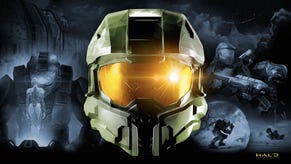Tech Analysis: Halo 3: ODST on Xbox One
Digital Foundry checks out the latest remaster and revisits The Master Chief Collection.
It's been nearly seven months since the troubled launch of Halo: The Master Chief Collection. November 11th 2014 marks the day that Halo fans everywhere were left out in the cold when the game hobbled out of the gate with serious functionality problems. While a number of other high profile releases shipped with nasty bugs, The Master Chief Collection is perhaps the most infamous of all. This is Halo we're talking about, after all. It's the most important franchise in Microsoft's stable. As good as the campaigns are, it's the series' multiplayer action that has kept fans playing for more than a decade now. Unfortunately, while the single-player modes were generally excellent, The Master Chief Collection was simply not fit for purpose when it came to online multiplayer.
It took a long time for the issues to be resolved, and 343 Industries attempted to smooth things over by offering early adopters a free copy of the Halo 3: ODST remaster as soon it was ready to launch. Six months after that announcement, the promised remaster is finally available for The Master Chief Collection, and with its release comes a new map and another round of changes and improvements.
Knowing how much has changed since launch, we felt it was high time to check back in on the game and see just how far along the collection has come. This leaves us with two real questions, then - firstly, how is ODST on the Xbox One and, secondly, have the release's larger problems been addressed? Diving right in then, there's no better place to start than the moody, jazz filled streets of New Mombasa with Halo 3: ODST.
As with Halo 3 and 4 before it, ODST was ported to the Xbox One by Ruffian games - an experienced British studio that has collaborated with Microsoft Studios on numerous products over the years. As expected, the game is bumped up to a full 1920x1080 resolution running at 60 frames per second, matching the rest of the collection (save for Halo 2 Anniversary). ODST was already an attractive game on Xbox 360 but the low 1152x640 resolution and lack of anti-aliasing resulted in a rather uneven presentation. The visual design really shines on Xbox One and while there is still room to make it better still, this updated version of ODST - with its native full HD resolution and decent anti-aliasing - offers a substantially improved presentation over the original release.
What's more, unlike the version of Halo 3 included with the collection, ODST now utilises anisotropic filtering to a limited degree. We pegged it somewhere around 4x AF with some blurry textures still evident at oblique angles, but the results are still a nice step up from the 360 version of ODST, as well as the Xbox One versions of Halo 3 and 4. Overall image quality is perfectly suitable for the game and exactly what we expected.
What hasn't been addressed is the low resolution HUD. As with Ruffian's other ports, ODST retains the original Xbox 360 font and HUD assets resulting in blurry, upscaled text and UI elements. From a normal viewing distance, it's less of an issue, but up close it's pretty ugly next to Halo 2 Anniversary's improved HUD. It's also worth noting that as with the rest of the collection, the Xbox One version of ODST also lacks the original 360 loading screens, which really fit the theme and visual language of the game. It may seem odd to lament the removal of loading screens but there are precious few games out there that can touch the lovely animated design Bungie crafted for its Halo titles.
ODST itself is a rather different game from Halo 3 when it comes to visual design. Focusing more on dramatic lighting and sprawling urban environments, the game rarely presents the type of natural terrain so common in Halo 3 - something which feels a bit chunky and dated in this collection. However, running through the streets of New Mombasa under the cover of a nocturnal thunderstorm remains as evocative and engaging as we remembered. All told, this type of visual design simply works much better here than it did with Halo 3 - LOD pop-in is less evident, structures exhibit a sense of solidarity and style, and lighting is even moodier than before. Only the human faces remain a weak point - just as they did in the original.
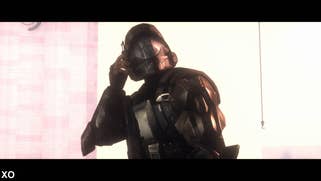

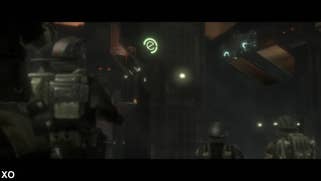
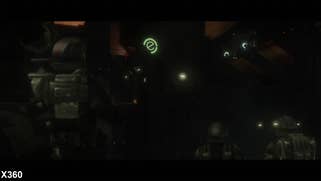

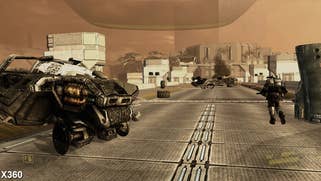
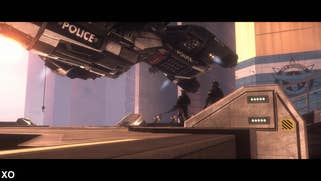

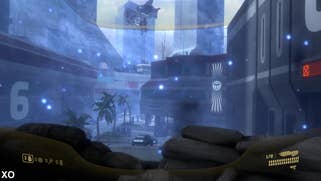
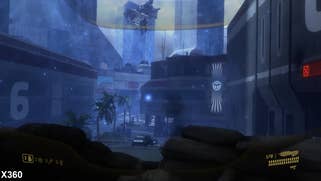
Thankfully, all of this is successfully retained and the presentation on Xbox One is extremely similar to the original 360 release. Aside from improved image quality, one of the first differences we spotted was the change in contrast. Using default settings, the Xbox 360 version appears a bit darker leading to some loss of shadow detail in certain scenes, while the Xbox One version seems over-exposed at times increasing the intensity of the bloom effects and resulting in a loss of detail on the opposite end of the spectrum.
Frame-rate is certainly improved, though it's not without its own issues. The original game operates at 30fps with noticeable frame-pacing issues, just like Halo 3 - something that also plagued Destiny during its original alpha period. Simply eliminating that issue makes a difference, but the jump up to 60fps allows the game to look nicer and feel more responsive.
Unfortunately the desired 60fps isn't maintained as often as we'd like - a number of major fire-fights induce noticeable dips in performance that see the frame-rate dive into the mid-40s. This issue tends to crop up more regularly than it did in Halo 3 and definitely detracts from the presentation, especially when nearly every mission in the game features at least one area where performance is impacted. While the results are still generally acceptable, we're a bit disappointed that every title in the Master Chief Collection still exhibits frame-rate issues at various points and to various degrees. Out of all the games, only Halo 3 can lay claim to a perceptually locked 60fps for the vast majority of its duration.
Ultimately, Halo 3: ODST is a pretty solid port, with much improved image quality and performance that far exceeds the original release. The fact that it still dips in major confrontations is a disappointment, but it still winds up feeling a tad more polished than most of the other games in the collection. The omission of the original's Firefight mode is bound to rankle with some, but in our opinion, it's a great addition and an excellent bonus for early adopters - the price is also very reasonable for those who didn't get the free code, weighing it at just £3.99/$4.99.
But what of the other four games in the package then? Since the launch of the collection, patches have focused primarily on improving the game's networking and matchmaking deficiencies. We played a number of matches across various Halo titles over the past week and experienced relatively short waiting times ranging between 30 seconds to three minutes, as well as generally stable performance. We did encounter a couple of matches that ended prematurely and even a crash that required the game to be restarted but all in all, it's worlds beyond the situation late last year. There were additional hurdles when attempting to join games with a party but with a little patience, we were able to enjoy some cooperative action.
Asking around online for other user experiences we noted that in general, players are reporting reasonably smooth experiences with most issues centering on the party system. There was a new bug introduced in Halo CE multiplayer which disabled bullet magnetisation (a mild skew in trajectory designed to make aiming easier), changing the feel of the game and making it much more difficult to hit players. Thankfully, the team is already aware of this issue and is working on addressing it. However, it is a bit disconcerting that these problems keep slipping through. Dealing with such a broad range of content across multiple engines, it's easy to see how these things might come to pass, but there's still sometimes the feeling that the fanbase is being used as substitute for decent QA. Still, despite the remaining problems, the game has reached a very playable state.
Of course, the early problems with online play is just one issue the collection has faced. In our original look at the game, we touched on a number of complaints encountered during the single player campaign and felt it was worth revisiting the games to see if any revisions or improvements have been made.
The original Halo CE campaign does not appear to have received any meaningful improvements to its Collection iteration. Frame-rate issues and tearing are still regular occurrences while the Anniversary visuals are engaged. Things fare better with a steady frame-rate in the classic mode but as before, a number of effects remain absent. The fog effects used in Assault on the Control Room, for instance, remain incorrect and ugly compared to the original Xbox version. The poorly aligned HUD is also present. Most of these differences are minor and will go unnoticed by the average Halo player, but it does detract from the archival nature of the package.
Halo 2 Anniversary is relatively unchanged outside of minor bug fixes. The most important of these is surely the save system, which was left in a non-functional state months after release instead requiring players to complete each mission in one shot. The menu system also updates completed missions properly - an issue we've had up until this latest patch. Areas with frame-rate dips still exhibit these issues, unfortunately. Halo 3 does not appear to have been touched in any meaningful way. Slow-down occurs in exactly the same areas while visual quality remains identical, meaning a completely lack of anisotropic filtering - the natural environments suffer quite a bit as a result, leading to muddy scenery. That said, Halo 3 still offers the most consistent frame-rate in the entire collection.
It's not all bad news though. Halo 4 has received genuine improvements to its performance, particularly in terms of streaming in new areas. Previously, we noted dips as low as 20fps during these segments, but now the slowdown is limited to small blips that really don't interrupt the flow of the game to anything like the same degree. There are still plenty of issues during actual gameplay of course, but it's certainly less problematic than the massive dips observed during background streaming.
It would seem that at launch, the system was bottlenecked during these loading sequences, resulting in a massive drop in performance. For example, the scene where the player is dropped into a pelican and launched out into the sky originally operated around 30fps for a solid 15 seconds. With the latest update, we see a dip occur only during the initial two seconds before the ship is even launched, giving the overall impression of a stable 60fps. Overall, this optimisation is very welcome, and helps to make moving between areas much more seamless.
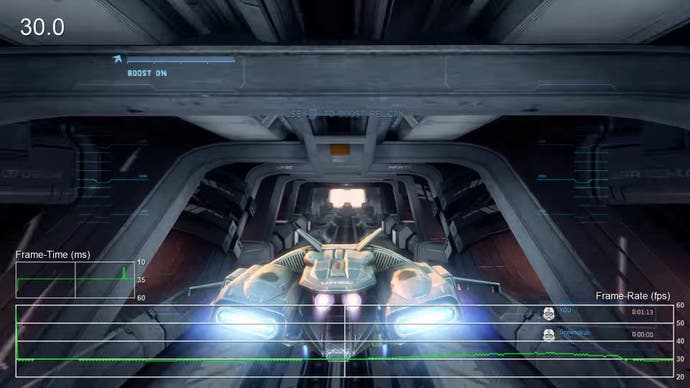
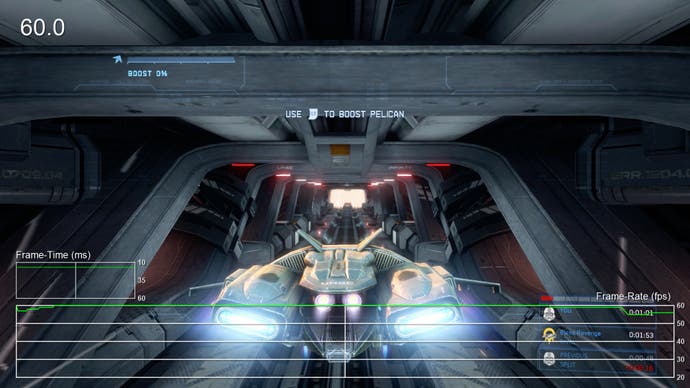
We still have a few other complaints with the package that we hope 343 addresses at some point. The Xbox One suspend feature simply does not work properly with The Master Chief Collection. It's been spotty with other games as well, but in this case it has never functioned correctly. Resuming a session from sleep either boots the player to the main menu while displaying an error noting that the user has changed or that the controller has been disconnected - something that often requires a restart of the game. We've even had the game simply crash on boot requiring a complete restart.
Then there are the loading times. While compiling comparison videos, it became quickly evident that the Xbox and Xbox 360 versions of these games simply load faster most of the time. When running from disc, an initial load on 360 may take longer, but once completed, loading any other mission is quite fast and painless while The Master Chief Collection requires a good five to ten seconds more in most cases. More irritating is the time it takes to return to the main menu from within a game. Selecting 'save and quit' results in a static "Halo: The Master Chief Collection" loading screen that persists for upwards of 10 seconds. Minor quibbles perhaps, but the menu system and navigation never feels as quick as it should because of these loading issues.
Despite these complaints, The Master Chief Collection is finally in a state where it's easy to recommend, whether you're interested in campaign or multiplayer gameplay. The package still isn't as refined as we would have liked but it's improved from launch with all modes now functioning in a mostly correct fashion. Multiplayer issues still crop up from time to time but it's nothing out of the ordinary and doesn't impede progress for long.
Still, it's not entirely clear when - or indeed, if - the game will finally reach a point where everyone is completely happy. Every section of the collection was farmed out to various development houses resulting in a massive project that 343 had to tie together into a single coherent product. With so many different game engines and developers in play it's easy to understand how this project became such a nightmare to manage. However, 343 Industries and its related studios have continued to hammer away on the game in order to correct these mistakes and bugs. The situation overall is disappointing, but at least users have not been abandoned. One would also hope that this experience would lead to a more cautious release of Halo 5 - the stakes are higher than ever this time and after taking such a battering to its credibility, 343 Industries has much to prove.






